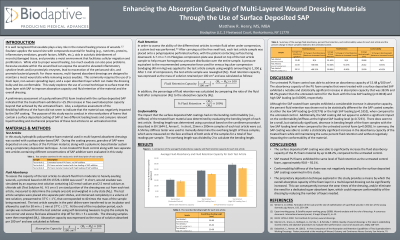Laboratory Research
(LR-010) Enhancing the Absorption Capacity of Multi-Layered Wound Dressing Materials through the Use of Surface Deposited SAP

Introduction: It is well recognized that exudate plays a key role in the natural healing process of wounds. Exudate supplies the wound site with compounds essential for healing (e.g., nutrients, proteins, inflammatory mediators, growth factors, MMPs, etc.), aids in autolytic debridement of necrotic/damaged tissue, and provides a moist environment that facilitates cellular migration and proliferation. While vital to proper wound healing, too much exudate can also pose problems. Excessive exudate within the wound bed can expose the wound to elevated inflammatory cytokine levels and/or proteolytic enzymes, lead to maceration of the periwound skin, and promote bacterial growth. For those reasons, multi-layered absorbent dressings are designed to maintain a moist wound site while removing excess exudate. This commonly requires the use of a foam layer, non-woven spreading layer, and a super absorbent layer which can make the dressing bulky and less conformable. This study explores the use of a novel technique to surface treat the foam layer with SAP to improve absorption capacity and fluid retention of the material and the overall dressing.
Methods: A hydrophilic polyurethane foam used in multi-layered absorbent dressings was treated with a polyacrylate-based SAP through a surface deposition technique. During this process, granules of SAP were deposited on one surface of the PU foam material, along with a polymeric-based binder system, using a proprietary deposition process. The treated foam was subsequently heat treated to activate the binder and bound the SAP to the foam. The free swell absorptive capacity of the SAP treated foam relative to a non-treated foam was evaluated according to the method described in BS EN 13827-1 section 3.2 using PBS.
Results: This assessment demonstrated that SAP treated foam exhibited a >25.9% increase in free-swell absorption capacity beyond that achievable by the non-treated foam. Additionally, the texture/hand of the foam did not appear to be negatively impacted by the deposited SAP.
Discussion: This surface deposition technique provides a means by which different layers in a multi-layered absorbent dressing can be treated with SAP to either improve the overall absorptive capacity of the dressing, thus increasing wear times, or reducing the need for a dedicated super absorbent layer.
Trademarked Items:
References:
Methods: A hydrophilic polyurethane foam used in multi-layered absorbent dressings was treated with a polyacrylate-based SAP through a surface deposition technique. During this process, granules of SAP were deposited on one surface of the PU foam material, along with a polymeric-based binder system, using a proprietary deposition process. The treated foam was subsequently heat treated to activate the binder and bound the SAP to the foam. The free swell absorptive capacity of the SAP treated foam relative to a non-treated foam was evaluated according to the method described in BS EN 13827-1 section 3.2 using PBS.
Results: This assessment demonstrated that SAP treated foam exhibited a >25.9% increase in free-swell absorption capacity beyond that achievable by the non-treated foam. Additionally, the texture/hand of the foam did not appear to be negatively impacted by the deposited SAP.
Discussion: This surface deposition technique provides a means by which different layers in a multi-layered absorbent dressing can be treated with SAP to either improve the overall absorptive capacity of the dressing, thus increasing wear times, or reducing the need for a dedicated super absorbent layer.
Trademarked Items:
References:

.png)